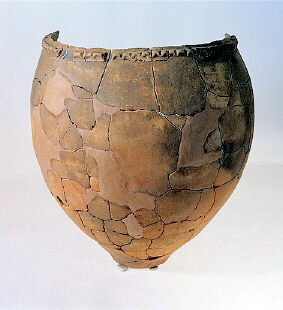hankyoreh
Links to other country sites 다른 나라 사이트 링크
Revised high school texts fuel controversy

Revised high-school history textbooks will describe the Bronze Age as having started in 2000 B.C. on the Korean Peninsula, up to one millennium earlier than what was claimed by previous textbooks. The textbooks will also state that the Gojoseon Kingdom, believed to be the first in Korea’s history, was firmly established by Dangun in 2333 B.C.
Dangun’s identity has been integrated into Korean foundation myths; however, scholars still debate whether he was an actual tribal chieftan or a symbolic figure.
Some say the moves come in the aftermath of controversy surrounding a 2004 posting on the Chinese Foreign Ministry’s Web site that called the Goguryeo (Koguryo) Kingdom (37 B.C.-668 A.D.) a part of Chinese history. China’s Northeastern Project, an historical research program, made the same claims in 2006. The Koguryo Kingdom, ethnically Korean, dominated the northern part of the Korean Peninsula and much of what is today Manchuria; it is considered a succesor to Gojoseon.
Indeed, scholars have pointed out several potentially controversial sections in the new standardized national textbooks, released by the Ministry of Education and Human Resources Development on February 23. According to the new books, the Bronze Age began on the Korean Peninsula between 2000-1500 B.C. Textbooks currently in use say that the Bronze Age began in about 1000 B.C. on the Korean peninsula and between 1500-1300 B.C. in Manchuria. The revised textbooks also say that dolmens (manmade rock formations found throughout Korea) also appeared between 2000-1500 B.C. and that people had by then established a native society on the peninsula.
Regarding the establishment of Gojoseon, a Korean kingdom believed to have existed in the Bronze Age, the new textbooks write, "Gojoseon was founded by Dangun in 2333 B.C." which replaces the earlier statement, "Gojoseon was reportedly founded by Dangun in 2333 B.C."
Gu Nan-hui, an official of the ministry, said that the government’s revisions were not "in response to" neighboring countries’ versions of history, as critics have charged. Regarding the change in the years describing the Bronze Age, the ministry considered demands to reflect recent archaeological evidence, said Gu. The section related to Dangun’s role in founding Gojoseon is in accordance with descriptions in current middle-school textbooks, he added.
Some scholars, however, have raised objections to the revisions. Professor Song Ho-jeong of Korea National University of Education said he was doubtful about Dangun’s establishment of Gojoseon in 2333 B.C., and said the contents of textbooks should be strictly based on historical records.
Dr. Oh Gang-won of the Northeast Asian History Foundation said that it would raise a controversy to declare the beginning of the Bronze Age as falling between 2000 B.C. and 1500 B.C. In addition, Dr. Oh said, the appearance of dolmens at that time has not been proven.
"It is very dangerous to react to China’s distorted nationalism in the same spirit. It is necessary to conduct more balanced research about the ancient history of Northeast Asia, including northeast China, the Korean peninsula, and Japan," said Dr. Oh.
Please direct questions or comments to [englishhani@hani.co.kr]
Editorial・opinion
![[Guest essay] Amending the Constitution is Yoon’s key to leaving office in public’s good graces [Guest essay] Amending the Constitution is Yoon’s key to leaving office in public’s good graces](https://flexible.img.hani.co.kr/flexible/normal/500/300/imgdb/original/2024/0416/8917132552387962.jpg) [Guest essay] Amending the Constitution is Yoon’s key to leaving office in public’s good graces
[Guest essay] Amending the Constitution is Yoon’s key to leaving office in public’s good graces![[Editorial] 10 years on, lessons of Sewol tragedy must never be forgotten [Editorial] 10 years on, lessons of Sewol tragedy must never be forgotten](https://flexible.img.hani.co.kr/flexible/normal/500/300/imgdb/original/2024/0416/8317132536568958.jpg) [Editorial] 10 years on, lessons of Sewol tragedy must never be forgotten
[Editorial] 10 years on, lessons of Sewol tragedy must never be forgotten- [Column] A death blow to Korea’s prosecutor politics
- [Correspondent’s column] The US and the end of Japanese pacifism
- [Guest essay] How Korea turned its trainee doctors into monsters
- [Guest essay] As someone who helped forge Seoul-Moscow ties, their status today troubles me
- [Editorial] Koreans sent a loud and clear message to Yoon
- [Column] In Korea’s midterm elections, it’s time for accountability
- [Guest essay] At only 26, I’ve seen 4 wars in my home of Gaza
- [Column] Syngman Rhee’s bloody legacy in Jeju
Most viewed articles
- 1[Guest essay] Amending the Constitution is Yoon’s key to leaving office in public’s good graces
- 2Faith the power of memory: Why these teens carry yellow ribbons for Sewol
- 3[Guest essay] How Korea turned its trainee doctors into monsters
- 4[Editorial] 10 years on, lessons of Sewol tragedy must never be forgotten
- 5US grants Samsung up to $6.4B in subsidies for its chip investments there
- 6[News analysis] Watershed augmentation of US-Japan alliance to put Korea’s diplomacy to the test
- 7How Samsung’s promises of cutting-edge tech won US semiconductor grants on par with TSMC
- 8Korea ranks among 10 countries going backward on coal power, report shows
- 9‘National emergency’: Why Korean voters handed 192 seats to opposition parties
- 10[Column] A death blow to Korea’s prosecutor politics